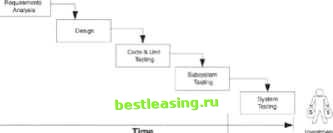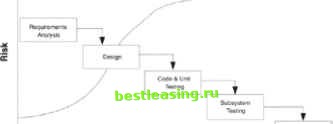

 |
 |

|
Промышленный лизинг
Методички
The Code-and-Fix Approach Code-and-fix is the most common of all development methods in the information technology environment. Code-and-fix is traditionally the methodology used to develop software applications. Additionally, the code-and-fix approach is the fastest and least efficient way of developing applications because this approach often gets out of control and ends up in trouble. There are literally no rules to code-and-fix, as IT developers find ways to skip corners and ignore key development steps. However, in a small startup company with only a few developers, this is often the way projects are managed. The recommendation for such a methodology is to gradually introduce key development templates, checklists, and controls into the development process. 1кШиШ=1 1иллл1М1Ы1Д V-Methodology The V-Model framework is a structured testing approach that can be used with any project management or system development methodology (see Figure 4.6). The framework emphasizes quality from the initial requirements stage through the final testing stage. It focuses on testing throughout the development life cycle, early development of test requirements, and early detection of errors. Each major deliverable in the development process is assessed, verified, validated, and tested. Work proceeds to the next stage in the V-Model when all project deliverables in a stage have met all verification and validation requirements. The process of verification and validation is an attempt to catch as many errors as possible in the development life cycle, otherwise know as stage containment. Pt4w* town Рпио* иэ ЩШяипШви Figure 4.6: V-methodology. N PREVIOUS NEXT H iJJ..HI8 The Waterfall Methodology The waterfall model originated in 1970 largely through the efforts of Dr. Winston Royce who developed this model as an aid to software development. It worked well at the time and has undergone many subsequent changes and revisions. From 1974 to 1976, Dr. Barry Boehm, a knowledgeable expert in his field, further developed the waterfall model into other project phases to better reflect current development best practices. The methodology, currently one of the most widely used, gets its name from the analogy of water falling downward. The waterfall model is a diagrammatical representation depicting the main phases of software development (see Figure 4.7). The first phase and its associated action are shown at the top left-hand corner of the diagram, and all subsequent project phases are placed toward the bottom right of the diagram. Each phase is called a work product. At the end of each phase, the result is either documents or deliverables, which in turn are used to proceed to the next phase.  I II I lliwllill ilipim  Figure 4.7: Waterfall development methodology. Note that the model in Figure 4.7 does not adequately allow for fixing any defects. It also does not address how to revisit previous project phases and go up the waterfall again when defects need to be corrected. This poses problems for some design and development groups. Although a great methodology, the waterfall model is difficult to use because it is incomplete in its original framework and structure. Revisions to the waterfall methodology have been made to accommodate project feedback, such as testing and quality assurance. However, the most commonly used version available today includes a corrective feedback mechanism. Figure 4.7 shows a remarkable difference between the two models. Some of the phases that should be used in the waterfall methodology follow: Requirements analysis. 1 2 3 4 5 6 7 8 9 10 11 12 13 14 15 16 17 18 19 20 21 22 23 24 25 26 27 28 29 30 31 32 33 34 35 36 37 38 39 [ 40 ] 41 42 43 44 45 46 47 48 49 50 51 52 53 54 55 56 57 58 59 60 61 62 63 64 65 66 67 68 69 70 71 72 73 74 75 76 77 78 79 80 81 82 83 84 85 86 87 88 89 90 91 92 93 94 95 96 97 98 99 100 101 |